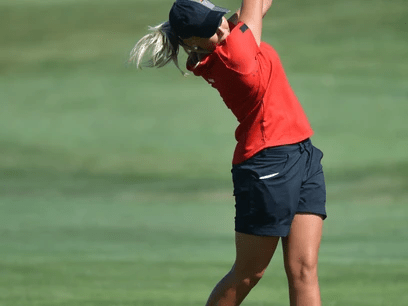Ever felt you’ve had a hard time getting “loaded” in your backswing, into your trail hip, and then difficulty with making the transition to your lead side during your downswing? This transition really should start occurring right before the downswing begins with the club – but that’s a different discussion on kinetics and kinematics of the golf swing….
For most golfers, the main reason they have difficulty with this movement pattern is a lack of adequate hip mobility into internal rotation. Many golfers will stretch their hips into external rotation (think of a pigeon stretch or a figure 4 stretch) to help with their hip stiffness, but this often will not address the problem they’re having with internal rotation.
You can see the internal rotation of the back leg on this golfer as she finishes her swing.
To check your internal rotation of your hips, simply sit in a chair and try to rotate your lower leg out to the side while not moving your upper leg – if you are unsure of what that looks like check out my previous blog here. For this test we want to make sure that we don’t cheat by lifting up the hips or by bending from our spine as we test each side.
Are you able to turn your hips at least 45゚with this hip internal rotation test? If not, then you’ve probably also experienced low back pain. The number one predictor of lower back pain in golfers is having limited hip rotation and lack of flexibility in the hips.
This is a big deal for longevity as a golfer and men over 40 most are most likely fail this test as this is the most commonly reported area of tightness in male golfers. Lack of flexibility in the hips can also potentially lead to swing changes that can cause neck pain, shoulder pain and back pain.
What can we do to improve our hip mobility for golf?
As always, make sure you get assessed to see what your body needs as each case has it’s individual elements vs. this general advice. However, the following may benefit many golfers.

Often we have tight hip muscles on the back of the hip and on the front of the hip. These muscles are the gluteus medius and the tensor fascia latae muscles. These two muscles together will restrict your hip mobility and can refer pain elsewhere (such as the lower back).
These areas are usually problematic because of overuse and because of lack of strength in the muscles. The brain likes to have stability in all of the different body segments of the golf swing as well as adequate mobility. When there’s an area that has a lack of stability, the brain (in order to create stability in the system) will create tightness to prevent you from over using an area that doesn’t have enough strength to do the things that you want to do with it. If not addressed this often will lead to the brain “giving ” you PAIN as a protective mechanism to prevent you from possibly injuring yourself.
Your Solution
Solutions for your flexibility problem depend on how you move specifically. If you haven’t already, checkout our Golf Home Assessment to see where you match compared to other golfers like you.
It’s important to start with “releasing” these muscles through stability and mobility training. Doing this will lead to you having more flexibility that you can use in your hips which will help your turn in your swing and make you a better golfer.
Remember to start working on improving your flexibility/mobility and strength little by little – you don’t need to do an hour of exercises each day. Start with something that you can consistently do for 5-10 minutes each day like the exercises in the videos below. Consistency over time with the right exercises will lead to improvements and results. If you can get 45 minutes a week working on your hips (preferably not at one time, but spread out throughout the week), that’s all you will need to start seeing results!
What’s Next?
Losing flexibility is something that DEFINITELY happens as we get older — BUT a lot of your flexibility problems can actually be prevented and/or decreased in severity. There will be more articles coming up soon going into more discussion about things you can do and exercises you can try to help with your flexibility and mobility – so stay tuned!
Dr. Grant Bishop, PT DPT, TPI Certified
Follow Dr. Grant and the CTG Golf Program on FB and IG or check out our Golf Therapy and Training Offerings.



